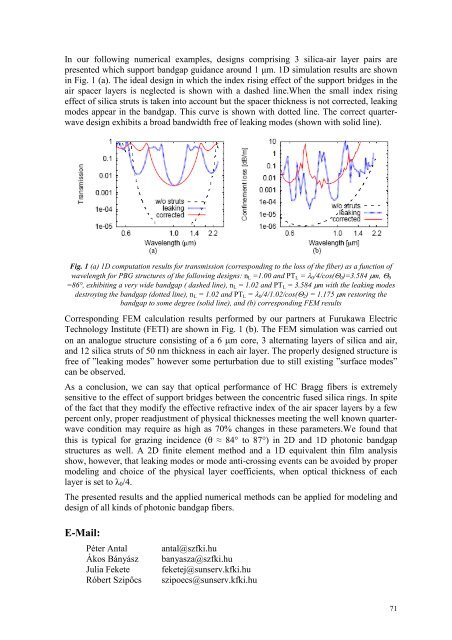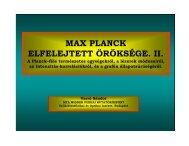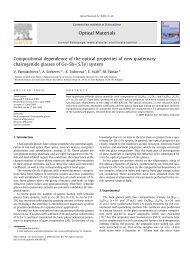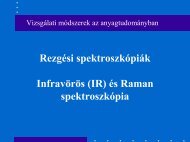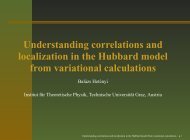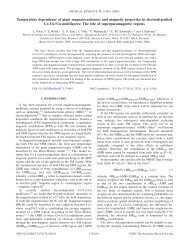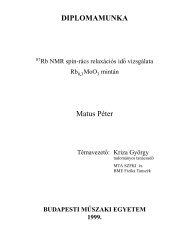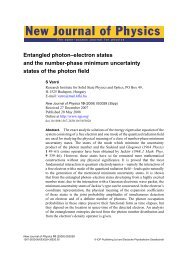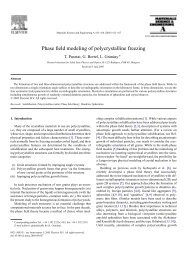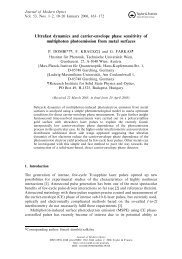ANNUAL REPORT - MTA SzFKI
ANNUAL REPORT - MTA SzFKI
ANNUAL REPORT - MTA SzFKI
You also want an ePaper? Increase the reach of your titles
YUMPU automatically turns print PDFs into web optimized ePapers that Google loves.
In our following numerical examples, designs comprising 3 silica-air layer pairs are<br />
presented which support bandgap guidance around 1 µm. 1D simulation results are shown<br />
in Fig. 1 (a). The ideal design in which the index rising effect of the support bridges in the<br />
air spacer layers is neglected is shown with a dashed line.When the small index rising<br />
effect of silica struts is taken into account but the spacer thickness is not corrected, leaking<br />
modes appear in the bandgap. This curve is shown with dotted line. The correct quarterwave<br />
design exhibits a broad bandwidth free of leaking modes (shown with solid line).<br />
Fig. 1 (a) 1D computation results for transmission (corresponding to the loss of the fiber) as a function of<br />
wavelength for PBG structures of the following designs: n L =1.00 and PT L = λ 0 /4/cos(Θ 0 )=3.584 µm, Θ 0<br />
=86°, exhibiting a very wide bandgap ( dashed line), n L = 1.02 and PT L = 3.584 µm with the leaking modes<br />
destroying the bandgap (dotted line), n L = 1.02 and PT L = λ 0 /4/1.02/cos(Θ 2 ) = 1.175 µm restoring the<br />
bandgap to some degree (solid line), and (b) corresponding FEM results<br />
Corresponding FEM calculation results performed by our partners at Furukawa Electric<br />
Technology Institute (FETI) are shown in Fig. 1 (b). The FEM simulation was carried out<br />
on an analogue structure consisting of a 6 µm core, 3 alternating layers of silica and air,<br />
and 12 silica struts of 50 nm thickness in each air layer. The properly designed structure is<br />
free of ”leaking modes” however some perturbation due to still existing ”surface modes”<br />
can be observed.<br />
As a conclusion, we can say that optical performance of HC Bragg fibers is extremely<br />
sensitive to the effect of support bridges between the concentric fused silica rings. In spite<br />
of the fact that they modify the effective refractive index of the air spacer layers by a few<br />
percent only, proper readjustment of physical thicknesses meeting the well known quarterwave<br />
condition may require as high as 70% changes in these parameters.We found that<br />
this is typical for grazing incidence (θ ≈ 84° to 87°) in 2D and 1D photonic bandgap<br />
structures as well. A 2D finite element method and a 1D equivalent thin film analysis<br />
show, however, that leaking modes or mode anti-crossing events can be avoided by proper<br />
modeling and choice of the physical layer coefficients, when optical thickness of each<br />
layer is set to λ 0 /4.<br />
The presented results and the applied numerical methods can be applied for modeling and<br />
design of all kinds of photonic bandgap fibers.<br />
E-Mail:<br />
Péter Antal<br />
Ákos Bányász<br />
Julia Fekete<br />
Róbert Szipőcs<br />
antal@szfki.hu<br />
banyasza@szfki.hu<br />
feketej@sunserv.kfki.hu<br />
szipoecs@sunserv.kfki.hu<br />
71


